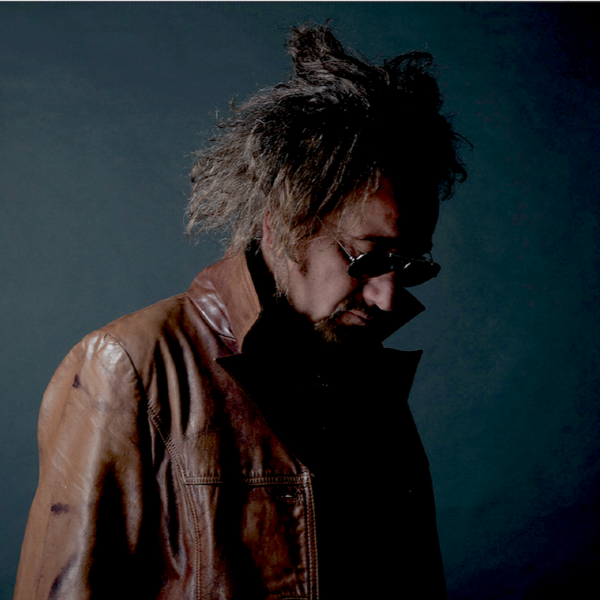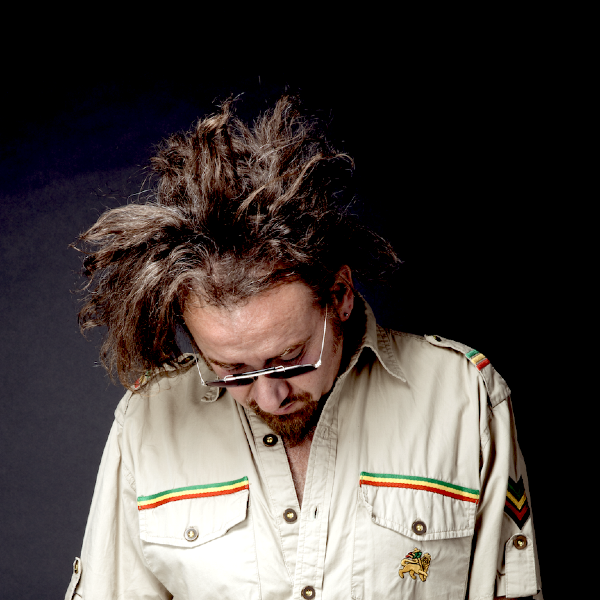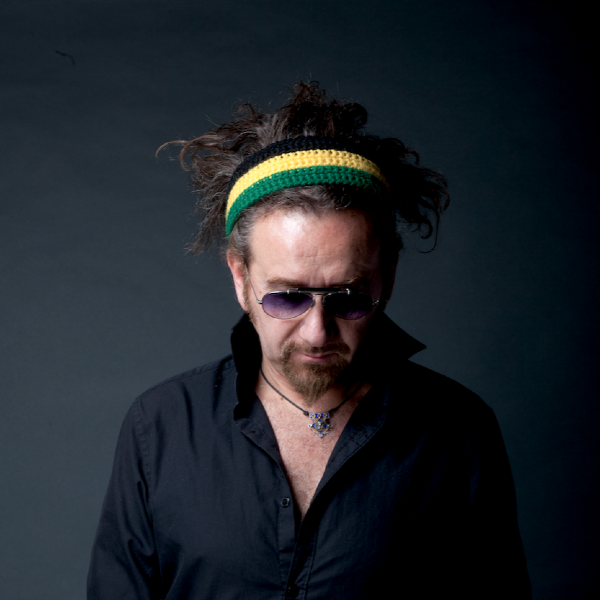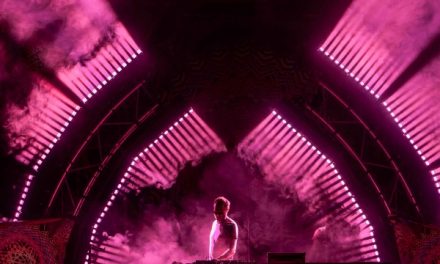On the centenarian anniversary of the Theremin, music maestro, Gaudi brings the instrument to his palette to produce an album as eccentric as the instrument itself, and as eclectic as his three-decade career. An enigmatic instrument that carries along with it a dark yet beautiful piece of history, the Theremin is like no other. Associated with eerie soundtracks and avant-garde music, and brought to the mainstream by rock stalwarts like The Beach Boys, Led Zeppelin and The Rolling Stones, the instrument is revived by Gaudi & his equally exceptional long-time collaborators. They adapt it with skill and reverence into a perpetual union with Dub. The result is a unique ornament of a record for the ages!
Interview by Mister Mime on 21/06/2021, edited by Shantiago.
100 years of Theremin (The Dub Chapter): What was your introduction to the instrument? And how is the sonic palette of the Theremin a good fit for the music you make?
In 1993, a cassette VHS documentary was released about Professor Leon Theremin, who passed away in 1991, and his discovery of the instrument. That got my interest, I bought it in 1994, and I’ve been playing it since. I use it in every gig and in many productions, and I think it’s a very unique instrument that can be very versatile. However, it’s a difficult instrument to play, takes years of study and it makes only one sound, so it can seem to be limited. 2020 was its 100-year anniversary so I took the opportunity to fuse it with my other passion for Dub & Reggae. I got in touch with my long-time collaborators Adrian Sherwood, Mad Professor, Dennis Bovell, Prince Fatty and The Scientist, and I did this album.
There has been such a boom in technology, not only within music and the instruments, but also involved in distributing music. Do you think these developments have affected music itself?
Yes, big-time. When I was younger, there was no internet or even computers. At the age of 16 or 17 years, I was working as an orthodontist to make a living. I would save some money and go to the record store on Saturday mornings, spend hours there and buy albums. When you buy music like that, you go deeper and you listen to everything. You read the credits, understand who the producer is, and the whole history. It’s a total experience.
Now, by having immediate access to every kind of music, it has become a bit disposable. When an album comes out, you tend to forget about it a few days later because you’re being bombarded constantly with new information. We have a certain capacity for information. If you’re not clever about how you buy, use and love music, you can fall into the trap of ‘Fast Food Music’.
Do you feel that ‘pop’ and commercial music have influenced music negatively?
The word “pop” is an abbreviation of popular music. Popular music is not derogatory, it’s just for the people. It’s easy art that gives access to non-musicians. Even “mainstream” is not offensive. It means that it reaches my mum, for example, and other people who may not know about music. Music is not divided into popular, mainstream, alternative, etc. It’s only divided into two sections; good music and bad music. Bad music can be Alternative, or the most researched music. With pop music, it’s the same thing. It could be very intelligent and beautiful, straight to the point stuff.
So, I wouldn’t say that pop music influenced music negatively. But bad music influences not so much music itself, but the listeners. At the end of the day, our music is given to listeners. When I’m making music, I need to love my music to death. I am a music connoisseur and I will always buy good music because I research it and I’ve spent time with it. I am passionate and thirsty. I want to eat music, drink music, make love with music.
I’m a musician 360 degrees round, and I don’t want to change. The main reason why I make music is that it makes me feel free. And that’s the thing I want to keep, this sense of freedom.
I want to ask you about your 2007 album ‘Dub Qawwali’. Very few people would be qualified to touch Nusrat Fateh Ali Khan’s music, as it needs a depth of understanding and respect for the music, as well as ability and competency. I feel your album really managed to do justice to his legacy. Can you share the story of how that came about?
I composed new and original music with Nusrat Fateh Ali Khan’s voice, given by Rehmat Gramophone, the label in Pakistan, and his wife. She passed me the studio reel with his unreleased material and I did a full album of original compositions. I would never remix the classics, like Nusrat or David Bowie. You can’t touch it.
Initially, every single track I received was a forty-minute Sufi devotional song or prayer, and I had to shrink them into 4-5 minutes. I didn’t want to do it following my own vibe. I wanted to understand what the master was saying in Urdu, in Hindi, so I employed a Pakistani translator with me for two months in the studio, and he wrote down every song. I spent two months studying what he said, how to cut it, and how not to time-stretch it. I wanted to keep the integrity of what he was saying.
Musically, I had an intuition that the Tabla is doing a similar off-beat approach to Reggae. Based on that principle, I experimented and adapted Nursat to Reggae and vice versa, with class, elegance and maximum respect, as that is the main thing to do. I can’t tolerate people who sample prayers, Indian chants or Nusrat and put it in a house music pre-set sound library. That’s disrespectful.

In the case of Nusrat Sahab’s vocals, for example, did you apply time stretching to the vocals?
I generally don’t do much time stretching. With Nusrat, I didn’t even want to think about it. Same thing when in 2003 I remixed Bob Marley. Those vocals are…perfect. One of the things I did with Nusrat Fateh Ali Khan in the track “Baithe Baithe Kaise Kaise”, I composed new music around it. Originally, the track was in 6/8 and I transformed it into 4/4. I adapted his voice without time-stretching in a way that went with the offbeat tabla. I didn’t touch his voice, I just moved it by a fraction. My remixes are usually very slow in comparison to the original. It’s physically slowing down the speed, like instead of 45rpm, you play it at 33. Whereas in time-stretching, you keep the same pitch and physically extend the waves. Slowing down is a very old principle, where physically everything is going to be played less, and hence even the pitch.
What drives you still after all these years and what would you say to younger musicians is the core principle to hold onto in the pursuit of exploring and making music?
Probably, understanding that music doesn’t have any rules or constrictions. You can decide what to do, and have the pleasure of going into something while knowing the risk. When I’m doing an album, my fan base expects a certain kind of album as a follow up to the last one and if I delude them with something unexpected, I could potentially risk losing some fans. But again, I don’t want to plan what’s happening on my next album or in my future movements. I can’t. All the people who follow me are with me and they know that if I’m going to release my next album like a tribute to Mozart, and I want to keep it as traditional, classical music with a 200-piece orchestra, they wouldn’t be shocked.
So, keep your integrity and follow your passion, because the main thing about making music is your own happiness. And whether you are authentic or not, people feel it in your music. When you are happy, you are authentic, because you’re delivering what you want. Another important thing is to create your own sound. There is too much stuff out there which sounds like many others. When I compose or listen to music, I still love albums. They are like books: you have chapters that create a book, and songs that create an album. That’s my concept.
Can you tell us about your other latest projects?
Oh there’s so much. I’ve produced a dub album with reggae legends, Steel Pulse. I’m doing a full album with African Head Charge, callee “Drums of Defiance” based on Nyabinghi, which is the very first form of Reggae music before Roots, Ska, Rocksteady and Mento. There’s a new single by DubFx, the album with Grouch, one new (Theremin) single… a band called Shanti Power from Italy… lot’s of stuff. I did the dub version of an album, Havana Meets Kingston, by a group consisting of Buena Vista Social Club members from Cuba and Mista Savona.
I love to work simultaneously on different projects. I love to switch, even mentally, cause I get a fresher approach when I go back and forth. It makes my brain work faster and more accurately. Sometimes when you’re focused on one thing for a long time, you lose perception of what’s going on.
How did you fall with Dub music and what is Dub to you?
I believe in music being essential in the sense of not using too many elements. I discovered that Dub adheres to this principle. The main thing is removing pre-existing elements, being creative with effects, and creating something new with something that already exists. Like, if you take an example from reggae music, Sly and Robbie, is drums and bass. And it works magically because there is a good synchronisation and an amazing flow. So I naturally apply this concept to any music, including non-Reggae. Keep it simple, transform it into something psychedelic using analogue effects and stuff. Once you have a solid groove and a good bassline, all the rest for me is arrangements. This is why I love Dub music.
I’d like to refer to your time spent in Africa. You mentioned that this was when you had a change in ideology as to keeping music simple and soulful. What was your experience that you had in Africa that changed your way of thinking about music?
It’s the simplicity. People like you and I, we save up money and then we buy an instrument. In Africa, especially in Burkina Faso which is the third poorest country in the world, they don’t have these possibilities. They use a djembe which they build up in Bobojulaso, a city known for djembe drums, and that’s it really. They have guitars with one or two strings maximum and it’s all recycled material, like a metal can of oil. They are very creative. When I saw what they could do with pretty much close to nothing, I started reflecting a bit on the power of the music itself, not as the instrument that you play it with.
When I started, I only had one keyboard, this one here, and one drum machine. I didn’t have the money to buy more stuff. So you start working with what you have and your creativity gets amplified. You think about how to create a certain sound, without having a synthesiser, but only one microphone. So when I created the kick drum, it was this: I took a microphone and tapped it on my leather studio chair, cause that’s all I had. And I didn’t have a hi-hat so I had to make the sounds with my mouth…”ts ts tsss…”, this kind of vibe. I didn’t want to be eclectic, it was simply because I didn’t have any other possibility and I’m still there working like that.
Back to Africa, when I saw this simplicity, it resonated with what I was doing when I was young. So instead of pushing forward, I stepped backwards. That was the main thing that resonated with me with the musicians down there.

This Dub principle you mentioned, does it exist as something well known in the dub world? Is it something that is established as a principle of the genre? Who came up with it?
Yes, it does. Sir Coxsone Dodd in Jamaica, in 1968, created this principle together with Lee Scratch Perry. They were the instigators of Dub music, and it happened in the most organic and simple way. A band was recording in the morning, and then they had to come back in the afternoon in the lunch break. In the meantime, the sound engineers Sir Coxsone Dodd and Lee Perry were waiting for this band to come back. They probably went to have a smoke, and they never came back. So while waiting for the band, they started playing around in the studio with what had been recorded which were the drums, bass and guitar. So they started playing with the echo, just for the sake of being creative. And the result was so excellent that they decided for the first time to include this “Dub” version on the “B-side” of the 7” 45rpm. And that was the very beginning, that was the start of Dub.
Slowly, “Dub” came to be also called “Version”, which is the same instrumental track without voice. So you would allow the DJs at the time to toast on top with the echo, in the dancehall. And slowly, people got so used to this dub version that in the late 70s and early 80s, they started buying the 7” more for the B-side than for the A-side. So eventually it was established as a genre.
You mentioned that one of the things that attracted you to Dub was the silence in the music. Can you elaborate on that?
I’ll give you a practical example: If I give you a simple beat with a kick, a snare and a hi-hat, in between the kick and the hat there is a micro-silence that makes the track breathe. The slower the BPM, the longer the silence. And that’s vital for music. I studied classical piano for 12 years. In classical music, there is something in Latin called the “Tacet”, translating to ’silence’. In orchestras, the instrumentalists would have say 32 bars of silence, and it’s part of the music. You only play when the moment comes. So, silence is a very important value that adds to the music. I think a lot before adding extra elements in order to fill up the track. I like the space in between the notes. I like this micro silent space that makes me breathe, so when the note kicks back, it has even more power. That’s my principle and it reflects quite a lot from the Dub principle as well.
In a broader sense how has your approach to remixing been?
Until 1995, I never did any remixes because at the time it was more associated with House music or Dance music. You do a House remix in order to make a “non-danceable” track playable in a disco. But I’ve never been a dance floor act myself, I’m a bit more of a live act. Then, when I moved to London, offers started coming in, including remix work to Janet Jackson’s AM PM label. I did a house-ish remix with the help of DJ Angelino, who was my partner, and we hit the spot. In November 1996, our single went #1 in the UK dance charts. That opened my eyes even further, and actually, I enjoyed it a lot. Slowly, after a few successes, remixes started coming in good numbers. Now, I’ve done about 135 remixes in my career and it’s something that I absolutely love.
Can you share some tips on how to approach a remix?
There aren’t many rules in music production. Technically, there are some. But creativity-wise, it’s infinite. So I’ll give you my perspective. I tend to stay miles apart from the original version in order to have more of an impact and be different. Keeping your identity, sound-wise, that’s another very important thing. You can’t do remixes and sound like a different artist every time. Having your trademark signature is very important. You create it slowly, it doesn’t happen overnight.
What are your thoughts on spirituality and religion?
I’m a very spiritual person myself. I’m not attached to any particular religion. Spirituality and religion are not necessarily combined. You can be extremely spiritual and have your own belief, and not necessarily put all your beliefs in one entity or thing only. When I worked on the Dub Qawwali album with Nusrat Fateh Ali Khan, he is a Sufi, and he sings Qawwali. I’m not a Sufi, and I’m not a part of that religion or that country. But that doesn’t mean that the two elements can’t coexist. In fact, the Dub Qawwali album is a good example of two different cultures ending in the same little molecule called LOVE, and transformed into music.
You can follow Gaudi on:
https://gaudimusic.bandcamp.com/
https://www.facebook.com/gaudimusic/
https://www.instagram.com/gaudimusic/



![[interview] with Suduaya](https://www.psybient.org/love/wp-content/uploads/Suduaya-experience-fest-main.jpg)

![[Interview] with Boom Festival](https://www.psybient.org/love/wp-content/uploads/boom_festival_BF2014_by_Pierre_Ekman-0714-cover.jpg)
